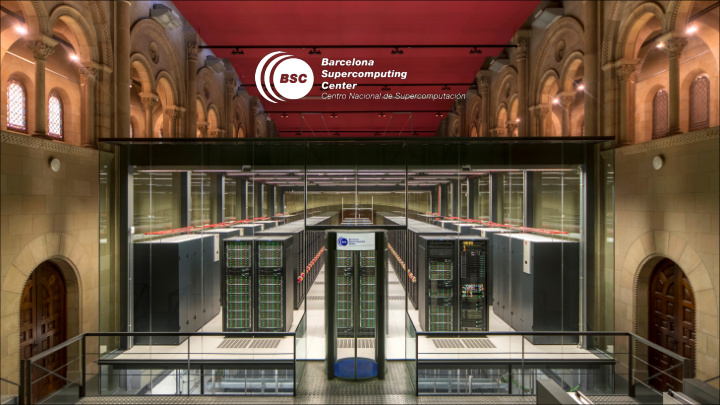



The Barcelona Supercomputing Center Sergi Girona Operations Director 04/12/2019 e-IRG workshop Dec 2019
Barcelona Supercomputing Center Centro Nacional de Supercomputación BSC-CNS objectives Supercomputing services R&D in Computer, Life, Earth and PhD programme, technology to Spanish and EU researchers Engineering Sciences transfer, public engagement Spanish Government 60% BSC-CNS is a consortium Catalan Government 30% that includes Univ. Politècnica de Catalunya 10%
People and Resources June 30, 2019 BSC Staff 2005 - 2018 800 605 529 600 475 447 433 358 321 310 302 400 279 229 164 114 200 65 0 2005 2006 2007 2008 2009 2010 2011 2012 2013 2014 2015 2016 2017 2018 BSC Staff 2018 executed budget
Mission of BSC Scientific Departments Computer Earth Sciences Sciences To influence the way machines are built, programmed To develop and implement global and and used: programming models, performance tools, regional state-of-the-art models for short- Big Data, Artificial Intelligence , computer architecture, term air quality forecast and long-term energy efficiency climate applications Life CASE Sciences To develop scientific and engineering software to To understand living organisms by means of efficiently exploit super-computing capabilities theoretical and computational methods (biomedical, geophysics, atmospheric, energy, social (molecular modeling, genomics, proteomics) and economic simulations)
MareNostrum 4 Total peak performance: 13,7 Pflops Ge General P Purpose Cl Cluster: 11. 11.15 15 Pflops (1 (1.07.2017) CT CTE1-P9 P9+Vol olta: 1. 1.57 57 Pflops (1 (1.03.2018) CT CTE2-Ar Arm V8: 0. 0.65 65 Pf Pflops (12. 12.2019 2019) CT CTE3-AM AMD Ro Rome+MI500: : 0. 0.52 52 Pflops (1 (12.2 .2019) Access: bsc.es/res-intranet Access: prace-ri.eu MareNostrum 2 MareNostrum 3 MareNostrum 4 MareNostrum 1 2006 – 94,2 Tflops 2017 – 11,1 Pflops 2012 – 1,1 Pflops 2004 – 42,3 Tflops 1 st Europe / 5 th World 2 nd Europe / 13 th World 12 th Europe / 36 th World 1 st Europe / 4 th World New technologies New technologies New technologies
MareNostrum 5. A European pre-exascale supercomputer 200 Petaflops peak performance (200 x 10 15 ) Experimental platform to create supercomputing Ho Hosting ng Cons nsortium: um: technologies “made in Europe” Spain Portugal Turkey Croatia 223 M€ of investment The acquisition and operation of the EuroHPC supercomputer is funded jointly by the EuroHPC Joint Undertaking, through the European Union’s Connecting Europe Facility and the Horizon 2020 research and innovation programme, as well as the Participating States Spain, Portugal, Croatia, and Turkey
MEEP, MareNostrum Experimental Exascale Platform • The MareNostrum Experimental Exascale Platform (MEEP) is a flexible FPGA-based emulation platform that will explore hardware/software co-designs for Exascale Supercomputers and other hardware targets, based on European-developed IP. • MEEP provides two very important functions: 1. An evaluation platform of pre-silicon IP and ideas, at speed and scale 2. A software development and experimentation platform to enable software readiness for new hardware. • MEEP enables software development, accelerating software maturity, compared to the limitations of software simulation. • IP can be tested and validated before moving to silicon, saving time and money. • The objectives of MEEP are to leverage and extend projects like EPI and the POP2 CoE in the following ways: • Define, develop, and deploy an FPGA-based emulation platform targeting European-based Exascale Supercomputer RISC-V-based IP development, especially hardware/software co-design. • Develop a base FPGA shell that provides memory and I/O connectivity to the host CPU and other FPGAs. • Build FPGA tools and support to map enhanced EPI and MEEP IP into the FPGA core, validating and demonstrating European IP. • Develop the software toolchain (compiler, debugger, profiler, OS, and drivers) for RISC-V based accelerators to enable application development and porting.
MEEP Research Stack HPC/DA Applications Profiling, Performance Monitors HW/SW Tools: LLVM, GDB, HPC/DA Runtimes Virtualization LINUX FPGA Shell: OS External Interfaces: I/O, DRAM, etc. Emulation Region: HBM Cores, Accelerators, & Caches FPGA Emulated HW FPGA Shell Emulation Region HBM HBM
MareNostrum 5 Final budget approved (GB EuroHPC) Acquisition [€] Operation[€] TOTAL TCO [€] MareNostrum 5 - overall budget 151.410.000 55.806.000 207.216.000 EuroHPC - contribution 75.705.000 25.700.000 101.405.000
MareNostrum5 concept Hosting Consortium: Ho Public Services Spain Portugal Turkey Login Nodes General Geant EuroHPC Purpose Applications: VM VM User General purpose partition, open to all • Compute Ethernet / Infiniband researchers with MPI, OpenMP codes, partition Virtual Server 200 PB Storage standard HPC codes. Scalable machine to run codes with high scalability, thousands of nodes. EuroHPC Service Accelerated partition: Any GPU application Head Nodes • User support Nodes ready to scale to thousands of GPUs Accelerated Any domain with workflows mixing General • Compute partition Monitoring Purpose and GPU, e.g. Earth science, Life science, Engineering, AI and AI driven BSC executions. LAN Scheduling EuroHPC Data Pre-Post Sysadmin processing nodes Fabric Managers Administrative Services To Backup and Archive Storage The acquisition and operation of the EuroHPC supercomputer is funded jointly by the EuroHPC Joint Undertaking, through the European Union’s Connecting Europe Facility and the Horizon 2020 research and innovation programme, as well as the Participating States Spain, Portugal, Croatia, and Turkey
MareNostrum 5 facilities
Thank you sergi.girona@bsc.es
Recommend
More recommend